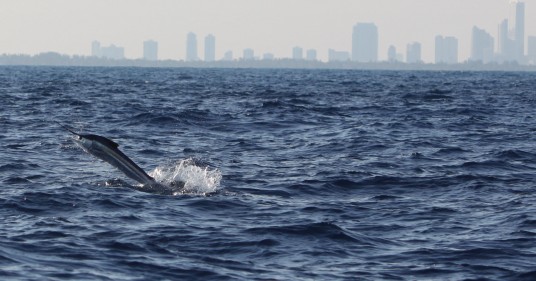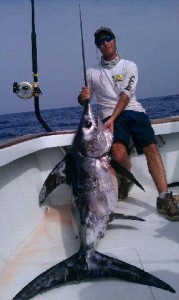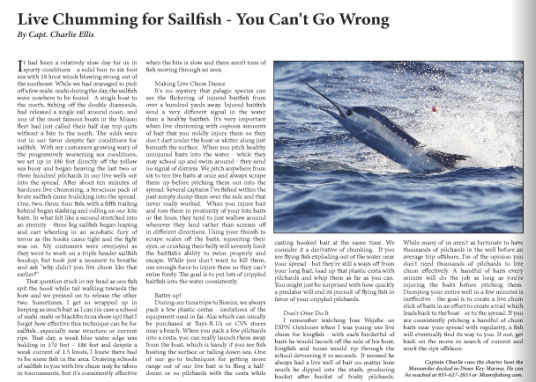I originally wrote this article for the April 2013 edition of Coastal Angler Magazine (Miami North Edition) but I figured it would be wise to post it here as well since it’s a valuable lesson that deserves to live on the internet! Yes it’s true – in my previous life I had a stint in journalism. While my writing for various newspapers never amounted to a career at a prestigious publication, it certainly gave me a head start in wordsmithing for the masses.
I truly enjoy writing for a fishing magazine and while I haven’t had the opportunity to grace the pages of Florida Sportsman or Saltwater Sportsman (yet), i’m hoping in time i’ll earn the right. For now, I’m privileged to share this article with everyone on the subject of live chumming for sailfish – a tactic we employ when the bite is slow but we know there’s fish in the area.
Live Chumming for Sailfish – You can’t go wrong!
By Capt. Charlie Ellis
Live Chumming for Sailfish – You Can’t Go Wrong by Capt. Charlie Ellis

It had been a relatively slow day for us in sporty conditions – a solid 4 to 6ft seas with 18knt winds blowing strong out of the southeast. While we had managed to pick off a few mahi mahi during the day, the sailfish were no where to be found. A single boat to the north, fishing off the double diamonds, had released a single sail around noon, and one of the most famous boats in the Miami fleet had just called their half day trip quits without a bite to the south. The odds were not in our favor despite fair conditions for sailfish.
With my customers growing wary of the progressively worsening sea conditions, we set up in 180′ directly off the yellow sea buoy and began heaving the last two or three hundred pilchards in our live wells out into the spread. After about 10 minutes of hardcore live chumming, a ferocious pack of brute sailfish came frolicking into the spread. One, two, three, four fish, with a fifth trailing behind began slashing and rolling on our kite baits. In what felt like a second stretched into an eternity – three big sailfish began leaping and cartwheeling in an acrobatic fury of terror as the hooks came tight and the fight was on. My customers were overjoyed as they went to work on a triple header sailfish hookup, but took just a moment to breathe and ask “why didn’t you live chum like that earlier?”
That question stuck in my head as one fish spit the hook while tailwalking towards the bow and we pressed on to release the other two. Sometimes, I get so wrapped up in keeping as much bait as I can (in case a school of mahi mahi or blackfin tuna show up) that I forget how effective this technique can be for sailfish…especially near structure or current rips. That day, a weak bluewater edge was holding in 170′ – 180′ and despite a weak current of 1.5knts, I knew there had to be some fish in the area. Drawing schools of sailfish to you with live chum may be taboo in tournaments, but it’s consistently effective when the bite is slow and there aren’t a ton of fish moving through an area.
Making Live Chum Dance
It’s no mystery that pelagic species can see the flickering of injured baitfish from over a hundred yards away. Injured baitfish send a very different signal in the water than a healthy baitfish. It’s very important when live chumming with copious amounts of bait that you mildly injure them so they don’t dart under the boat or skitter along just beneath the surface. When you pitch healthy uninjured baits into the water – while they may school up and swim around – they send no signal of distress. We pitch anywhere from six to ten live baits at once and always scrape them up before pitching them out into the spread. Several captains i’ve fished with in the past simply dump them over the side and that never really worked. When you injure bait and toss them in proximity of your kite baits or flat lines, they tend to just wallow around wherever they land rather than scream off in different directions. Using your thumb to scrape scales off the baits, squeezing their eyes, or crushing their belly will severly limit the baitfish’s ability to swim properly and escape. While you don’t want to kill them, use enough force to injure them so they can’t swim freely. The goal is to put lots of crippled baitfish into the water consistently.
Batter up!
During our tuna trips to Bimini, we always pack a few plastic Cestas – imitations of the equipment used in Jai-Alai which can usually be purchased at Toys R Us or CVS stores near a beach. When you pack a few pilchards into a Cesta, you can really launch them away from the boat, which is handy if you see fish busting the surface or tailing down sea. One of our go-to techniques for getting more range out of our livebait is to fling a half-dozen or so pilchards with the cesta while casting a a hooked bait at the same time. We consider it a derivative of chunking. If you see flying fish exploding out of the water near your spread – but they’re still a ways off from your long bait, load up that plastic Cesta with pilchards and whip them as far as you can. You might just be surprised with how quickly a predator will end its pursuit of flying fish in favor of your crippled pilchards.
Don’t Over Do It
I remember watching Jose Wejebe on ESPN Outdoors when I was young use live chum for kingfish – with each bucketful of baits he would launch off the side of his boat, kingfish and tunas would rip through the school devouring it in seconds. It seemed he always had a live well of bait no matter how much he dipped into the stash, producing bucket after bucket of frisky pilchards. While many of us aren’t as fortunate to have thousands of pilchards in the well before an average trip offshore, i’m of the opinion you don’t need thousands of pilchards to live chumeffectively. A handful of baits every minute will do the job as long as you’re injuring the baits before pitching them. Dumping your entire well in a few minutes is ineffective – the goal is to create a live chum slick of baits in an effort to create a trail which leads back to the boat – or to the spread. If you are consistently pitching a handful of chum baits near your spread with regularity, a fish will eventually find its way to you. If not, get back on the move in search of current and work the rips offshore.

Capt. Charlie Ellis

Latest posts by Capt. Charlie Ellis (see all)
- Curious how to catch or buy live bait in Miami, Florida? Here’s what you need to know! - October 28, 2016
- A Legacy of Venice Louisiana Tuna Fishing - April 7, 2015
- Four Miami, FL Fall Fishing Tips - September 2, 2014

Comments